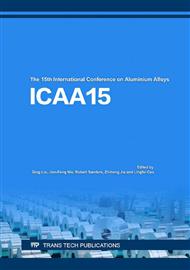[1]
T. Herding, O. Kessler, F. Hoffmann, P. Mayr, An approach for continuous cooling transformation (CCT) diagrams of aluminium alloys, Mater Sci Forum. 396-402 (2002) 869-874.
DOI: 10.4028/www.scientific.net/msf.396-402.869
Google Scholar
[2]
B. Milkereit, O. Kessler, C. Schick, Recording of continuous cooling precipitation diagrams of aluminium alloys, Thermochim. Acta. 492 (2009) 73-78.
DOI: 10.1016/j.tca.2009.01.027
Google Scholar
[3]
B. Milkereit, N. Wanderka, C. Schick, O. Keßler, Continuous cooling precipitation diagrams of Al-Mg-Si alloys, Mater Sci Eng. A 550 (2012) 87-96.
DOI: 10.1016/j.msea.2012.04.033
Google Scholar
[4]
Y. Zhang, B. Milkereit, O. Kessler, C. Schick, P.A. Rometsch, Development of continuous cooling precipitation diagrams for aluminium alloys AA7150 and AA7020, J. Alloy. Compd. 584 (2014) 581-589.
DOI: 10.1016/j.jallcom.2013.09.014
Google Scholar
[5]
M.J. Starink, B. Milkereit, Y. Zhang, P.A. Rometsch, Predicting the quench sensitivity of Al-Zn-Mg-Cu alloys: A model for linear cooling and strengthening, Materials and Design. 88 (2015) 958-971.
DOI: 10.1016/j.matdes.2015.09.058
Google Scholar
[6]
D. Zohrabyan, B. Milkereit, O. Kessler, C. Schick, Precipitation enthalpy during cooling of aluminum alloys obtained from calorimetric reheating experiments, Thermochim. Acta. 529 (2012) 51-58.
DOI: 10.1016/j.tca.2011.11.024
Google Scholar
[7]
P. Schloth, J.N. Wagner, J.L. Fife, A. Menzel, J. Drezet, H. van Swygenhoven, Early precipitation during cooling of an Al-Zn-Mg-Cu alloy revealed by in situ small angle X-ray scattering, Appl Phys Lett. 105 (2014).
DOI: 10.1063/1.4894768
Google Scholar
[8]
A. Hayoune, D. Hamana, Structural evolution during non-isothermal ageing of a dilute Al-Cu alloy by dilatometric analysis, Journal of Alloys and Compounds. 474 (2009) 118-123.
DOI: 10.1016/j.jallcom.2008.06.070
Google Scholar
[9]
H.R. Mohammadian Semnani, H.P. Degischer, Precipitation in AlCu4. 3 and AlCu4Mg alloys studied by dilatometry and calorimetry, Kovove Materialy-Metallic Materials. 49 (2011) 369-374.
DOI: 10.4149/km_2011_5_369
Google Scholar
[10]
K. Pieła, L. Błaz, Z. Sierpiński, T. Foryś, Non-isothermal annealing of aa7075 aluminum alloy - Structural and mechanical effects, Archives of Metallurgy and Materials. 57 (2012) 703-709.
DOI: 10.2478/v10172-012-0076-6
Google Scholar
[11]
L. Hadjadj, R. Amira, M. Bouchear, Comparative study of the phenomena of precipitation in Al-Zn-Mg alloy by the differential scanning calorimetric and the dilatometry and interpretation of dilatometric effects, Int. J. Mod. Phys. B 26 (2012).
DOI: 10.1142/s0217979212500762
Google Scholar
[12]
M. Hamoudi, B. Said, M.T. Bouziane, Influence of thermomecaniques treatments on the proprietes of Al-5. 8% Zn-2. 7% Mg alloy, Materials Sciences and Applications. 3 (2012) 509.
DOI: 10.4236/msa.2012.38071
Google Scholar
[13]
M.I. Daoudi, A. Triki, A. Redjaimia, C. Yamina, The determination of the activation energy varying with the precipitated fraction of β" metastable phase in an Al–Si–Mg alloy using non-isothermal dilatometry, Thermochimica Acta. 577 (2014) 5-10.
DOI: 10.1016/j.tca.2013.12.007
Google Scholar
[14]
M. Kövér, P. Sláma, Aluminium alloys measurement in quenching dilatometer and application of the data, AMR. 1127 (2015) 73-77.
DOI: 10.4028/www.scientific.net/amr.1127.73
Google Scholar
[15]
M. Kumar, N. Ross, I. Baumgartner, Development of a continuous cooling transformation diagram for an Al-Zn-Mg Alloy using dilatometry, MSF. 828-829 (2015) 188-193.
DOI: 10.4028/www.scientific.net/msf.828-829.188
Google Scholar


